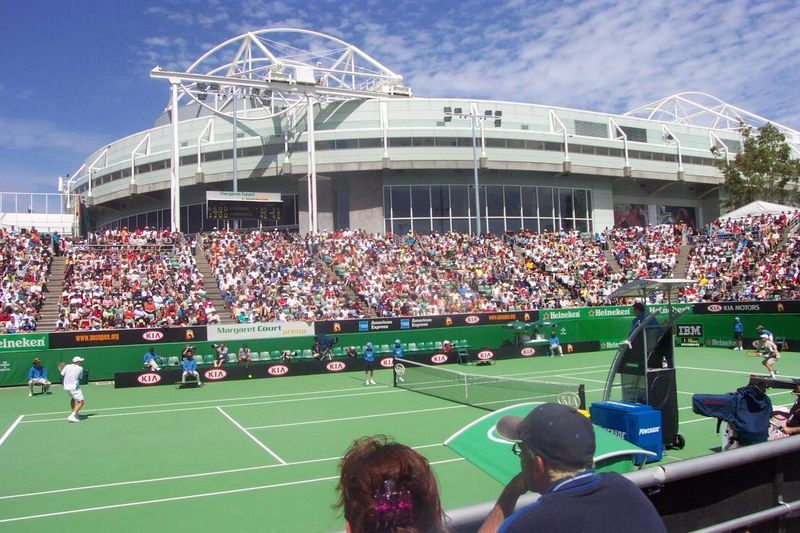2. The player training on the court was Rafa Nadal
The Australian Open1
In 2008, the Rebound Ace surface, which had been in place for the previous 20 years at Melbourne Park, was replaced by a cushioned, medium-paced, acrylic surface known as Plexicushion Prestige. The main benefits of the new surface are better consistency and less retention of heat. The change was controversial because of the new surface's similarity to DecoTurf, the surface used by the US Open.
The singles winners in 2010 were Roger Federer and Serena Williams. In men's doubles, the winners were Bob and Mike Bryan, and in women's doubles, the winners were Serena and Venus Williams - the second time in history that both doubles titles were won by siblings, and for the second consecutive year at the Australian Open.
 |
| By Skyscraper297. C. Commons |
The tournament was first known as The Australasian Championships and then became the Australian Championships in 1927 and the Australian Open in 1969. Since 1905, the Australian Open has been staged in five Australian and two New Zealand cities as follows: Melbourne (54 times), Sydney (17 times), Adelaide (14 times), Brisbane (7 times), Perth (3 times), Christchurch (in 1906), and Hastings (in 1912). In 1972, when it was decided to stage the tournament in the same city each year, the Kooyong Lawn Tennis Club was selected because Melbourne attracted the biggest patronage.
Melbourne Park was constructed for the 1988 tournament to meet the demands of a tournament that had outgrown Kooyong's capacity. The move to Melbourne Park was an immediate success, with a 90 per cent increase in attendance in 1988 (266,436) on the previous year at Kooyong (140,000).
Because of its geographic remoteness very few foreign players entered this tournament at the beginning, which made it an uninteresting tournament. In the 1920s, the trip by ship from Europe to Australia took about 45 days. The first tennis players coming by aircraft were the US Davis Cup players in November 1946. Even inside the country, many players could not travel easily. When the tournament was held in Perth, no one from Victoria or New South Wales crossed, by train, a distance of some 3000 kilometres between the east and west coasts.
 |
| By Ivan. Public domain |
Read and listen to the passage carefully. Then, answer the following questions.
1. According to the text, has the Australian Open always been contested on hard courts?
2. Why was the surface of the courts changed in 2008?
3. According to the text, why was Melbourne Park an immediate success?
4. Why didn't players take part in the first Australian Open tournaments?
In the passage above there are several relative clauses. Fill in the chart to identify them.
| Defining | Non-defining |
But those are not the only relative clauses in the passage. There are others. Some examples are:
1. Before entering the court, he reads a big poster on the wall of one of the corridors.
2. The first tennis players coming by aircraft were the US Davis Cup players in November 1946.
3. The Australian Open is the first of the four Grand Slam tennis tournaments held each year in January at Melbourne Park.
4. ...very few foreign players entered this tournament at the beginning, which made it an uninteresting tournament.
Relative clauses 1, 2, and 3 are known as "reduced relative clauses", and we are going to concentrate on them right now. In sentence number 4, the relative clause does not modify a noun (antecedent), but the whole previous sentence, and it will be studied in the following section.
If you feel like watching the video again and getting the information provided in it, click here (pay attention to the plugins needed).
Time to practice! Have a look at this interesting exercise on the web!
Which of the following relative clauses would be the correct ones for the "reduced" ones?
1. Before entering the court, he reads a big poster on the wall of one of the corridors.
|
a. ... who was on the wall of the corridors.
| |
|
b. ...which/that was on the wall of the corridors.
|
|
a. ...whom came by aircraft...
| |
|
b. ...who/that came by aircraft...
|
|
a. ...which/that is held each year in January at Melbourne Park.
| |
|
b. ... where is held each year in January at Melbourne Park.
|
|
a. ...who/that was training on the court...
| |
|
b. ...who/that played on the court...
|